#salt fat acid heat character group
Explore tagged Tumblr posts
Text

Still thinkin about them
#mdzs#and then dragon LXC#yeehaww#salt fat acid heat character group#ive said it before and ill say it again
52 notes
·
View notes
Text
thank you for the tag @yourpigeonwife!!
last book I read: Daisy Jones and the Six! I was really late to the party w this book but I enjoyed it more than I thought I would! The interview style was surprisingly fun and I liked the twist at the end :)
a book I recommend: Educated I feel like I'm always recommending this book to people, especially other Americans who don't know a lot about homeschooling and some of the more insular religious groups in the US.
a book I couldn’t put down: Circe This was the first book I read in looooong time where I felt literally glued to the words on the page. I just re-read it a little while ago and I felt the same way!
a book on my tbr: Thursday Murder Club! I saw this in a bookstore and the premise looks so cool! I just found the book on libby so it's definitely up on my list!
a book I’ve put down: Priory of the Orange Tree. The book is super big so I only read it at home, while I take my kindle on the bus and to coffee shops and stuff. I think I just went too long between chapters and then all the different povs and plots got confused in my mind! I'm going to try to read it again while really paying attention to the different characters when I get back home
a book on my wishlist: Braiding Sweetgrass. I've wanted to buy this book for such a long time, it's been recommended to me by tons of people! Once I have some extra money I'm definitely going to buy a copy
a book I would give to a friend: Salt, Fat, Acid, Heat. I feel like it's a good book for my friends who are around age that are graduating and just starting to live on their own. Learning to cook is important!
a book of poetry/lyrics I own: Love that dog I definitely don't read a lot of poetry but Sharon Creech was one of the first poets I read and fell in love with when I was just starting to read!
a non-fiction book you own: Las venas abiertas de America Latina, A super important book for anyone interested in the history of colonization and imperialism in latin america. There's both a spanish and an english version i think
currently reading: Hey Hun. This book is about white-supremacy, fake feminism and the general cult-y stuff that goes down in multi-level marketing schemes but told as like a first-person narrative. The writing style is little bit bubbly for my taste but overall super interesting!
planning on reading next:Piranesi! I got the libby notification that this book was off hold and ready for me to borrow as I was reading this, yippee!
I'll tag @lil-shiro @spursracing @caleb-is-existing and anyone else that has read good books in 2024 and would like to share! No pressure, of course :)
5 notes
·
View notes
Text
The Chemistry Behind Dr. Stone
Dr Stone is a Shounen manga and later an anime that it's the story of Ishigami Senku, an extremely talented high schooler that woke up 3700 years after all humanity had been instantaneously petrified. Nothing of our known world is left, and planet earth is now reset to a Stone Age. No buildings, no internet, no human artefacts.. I, as a chemistry student I couldn't be more interested on an anime that focus on science.

At the start of this history, Senku makes soap using the chemical reaction called Saponification, this is a process that involves conversion of fat, oil or lipid into soap and alcohol by the action of heat in the presence of aqueous alkali (for example, Senku uses Calcium Carbonate as a base). Soaps are salts of fatty acids and fatty acids are monocarboxylic acids that have long carbon chains.

Later in the history we got to know new characters, one of them is sick with an unknown illness, so Senku needs to make a drug that deals with a large number of diseases, as are the sulfa drugs. In this era, making a Sulfa drug is a relatively easy process, because we can buy the reactives in any laboratory (Merck, Sigma, etc) but when you live in the stone age is a little bit harder.

First they do Hydrochloric Acid (HCl) mixing Sulfuric Acid (H2SO4) and salt (NaCl). This first step it's one of the most important ones, because with HCl, they can make Chlorosulfuric Acid (HClSO4). The process is simple, they mix the Hydrochloric Acid with Sulfuric Acid. The Chlorosulfuric Acid acts as an elecrophile for the formation of the drug, an elecrophile is a specie with lack of electrons. Then they work with coal tar, this substance has a lot of compounds (approximately 10,000 chemicals, of which only about 50% have been identified), thats why they washed with HCl to clean it of the non aromatic compounds of it. Later they added Ethyl acetate, obtained by the methylation of vinegar. With this mixture, the aniline is created.

The aniline is both a compound and a family of compounds. The aniline is an organic compound with the formula C6H5NH2. Consisting of a phenyl group attached to an amino group, aniline is the simplest aromatic amine. Senku uses this compound as a building block of the sulfa drug. With aniline and acetic anhydride it forms Acetanilide. The Acetanilide it's treated with the Chlorosulfuric Acid to get para-acetamidobenzensulfonyl chloride . When the para-acetamidobenzensulfonyl chloride is mixed with ammonia (from pee) you get the para-acetamidobenzensulfonic acid. Finnaly the last step it's a simple recrystallization.

I really got invested in this anime (and subsecuently the manga) because you know, I'm something as a scientist myself. This work it's pretty accurate in his scientific approach, and it's a very funny anime to watch.

Tomás Chávez Vega
6 notes
·
View notes
Text
What TO Stock for An APOCALYPSE, PART THREE (Updated)
Right up there next to water, a top-priority post-apocalypse need will be FOOD.
5. THE FOOD you will need:
Since most of us will be short on water, dried beans and other foods that require a lot of water for cooking may not work out too well. Dry beans also need a lot of cooking time, meaning more firewood or other fuel. Canned goods are a practical way to go (and most come with some liquid inside), though it would be hard to stock enough to last years. Plus, canned goods can get mighty unappetizing over time, and will eventually spoil.
To survive well without getting malnourished, you’ll need protein, carbohydrates, vitamins, minerals, and a little fat – the basic food groups, though meat and dairy aren’t essential. Unless you have your own well-guarded farm or hunting preserve, you can’t count on being able to eat meat. And if you’re growing your own food, in most cases you will get much more protein per acre by growing beans instead of animals. But chickens and milk goats can be very useful and will take up less space than other critters (though you’ll need to learn animal husbandry between now and the end of the modern world).


Whole proteins are made up of eight essential amino acids. Most beans and nuts have seven of those acids, while most grains have only one. To get whole protein from beans or nuts, you need a companion grain to eat with them to make the protein complete. Think beans and rice, beans with tortillas, beans with cornbread, hummus with chips, peanut butter sandwiches (made with pancakes or biscuits cooked over an open fire).




Soybeans have the full eight essential amino acids, but they take a lot of time and water to cook. My personal experience with them (which is extensive) is that they aren’t digestible unless they’ve been pressure-cooked for at least an hour, and pressure cookers can be dangerous and hard to come by. Soybean skins tend to plug up the vent holes. If the cooker isn’t removed from the fire immediately and the skin isn’t removed from the vent, the cooker could explode. People can get burned by the buildup of steam inside the cooker.
Soybeans are a pain, BUT, if you need whole protein, they will provide it. The flavor is not the best, the texture can be off-putting, but they’re not bad in tortillas with salsa and fresh veggies. Once the beans are cooked, you can make decent patties out of them if you have anything to flavor them with. Some women, like me for instance, can’t eat soybeans when they’re pregnant, and soy allergies are serious issues for many. If you have a lot of water, you can make soybeans into soy milk and tofu. There’s also tempeh, the making of which is an artform.



You can make milk out of lots of things these days: almonds, oats, rice, hemp (my fave). I don’t have a clue how to make these things, but I’m sure you can figure it out—if you get to googling while the internet still works.
In my novel, prepper Grandma Bea stocks barrels and bags of many kinds of beans, flours, oatmeal, rice, sugar, cooking oil, peanut butter, sugar, salt and pepper. She has cases of canned goods—mostly soup, chili, and stew—and cases of powdered milk and eggs.
6. GROWING FOOD
If you want to get serious about providing for long-term survival (or if you just want to live more sustainably), you will need to do more than stockpile food. You need to set yourself up with ways to grow it. Think garden beds full of rich soil, compost piles, bee hives for honey and pollination, fruit trees and vines, and ways to scare off the birds. And you need to stockpile seeds that suit your soil, drainage, and growing season, along with plenty of organic fertilizer and the tools and equipment to help it all grow. You’ll need to get creative about where and how to grow this food: in your suburban yard, inside in front of your windows, in pots and buckets and barrels, on rooftops and ledges, along fences, etc., etc.






My main character, Bea, has fresh tomatoes, peppers, squash, greens, purple hull peas, and herbs growing in pots and in her garden. She has a second garden full of root veggies, and she has a bee hive installed in an exterior wall. A few neighbors have chickens. One family has some rabbits. When the neighbors finally get organized, Bea has plans for urban farming that involve building gardens and compost piles in yards and vacant lots, and later plowing up front yards for cornfields, and the neighborhood park to try growing winter wheat and other grains in the scorching Texas heat.
7. STORING & PRESERVIING FOOD
In my novel, Bea has a root cellar full of root veggies: russet and sweet potatoes, carrots, garlic, and onions. Beets don’t grow so well in Texas as far as I know (meaning, I don’t actually know). Turnips are, well, turnips, but they last a long time in cool, dry storage. Parsnips, rutabagas, and Jerusalem artichokes are other good root veggies to grow and store.
Root cellars are awesome if you can keep them from filling with ground water. Being under the earth tends to keep the temperatures nice for storage of food with a long shelf-life, like root veggies and—for a lesser length of time—compact cabbages, pumpkins, and winter squash (butternut, acorn, etc.)


Though impractical when water is scarce, home canning is also a good way to store food. Many foods can be dried, which only requires water for cleaning before and after drying. Of course, you’ll need water to reconstitute most dried foods before you eat them, with dried fruit and jerky being the primary exception to this, and field corn, which can be ground into cornmeal.





On top of growing and preserving food, you also need to know how to preserve seed, since there will be no seed catalogues, no seed companies. The Seed Savers Exchange is one of many good resources for this: https://www.seedsavers.org/how-to-save-seeds.
Remember that you will also need biodiversity (more than one kind of seed for each veggie) to give you better odds that some types will survive a blight, fungus, or insect attack. And you need to protect your pollinators: bees, wasps, butterflies, etc. Know your bugs and learn to distinguish the helpful ones from the harmful ones. Crickets can be eaten (sorry, but you may need to know this someday).

I could go on about food forever (I already have, lol), but going further would be beyond the scope of this blog. My advice is to get busy studying up.
If all else fails, you can follow the example of Mad Max in ROAD WARRIOR and chow down on yummy dog food.

We may find ourselves eating this poor guy out of our backyard someday:

To see how my unlikely apocalyptic hero, seventy-year-old Bea Crenshaw, shepherds her grandkids and neighbors through the aftermath of a solar pulse, check out IF DARKNESS TAKES US on Amazon: https://www.amazon.com/Darkness-Takes-Brenda-Marie-Smith-ebook/dp/B07WK9BQHN or order it from your favorite indie bookstore:
The sequel, IF THE LIGHT SHOULD COME, will be out June 2021 from SFK Press.
STAY TUNED FOR FUTURE INSTALLMENTS OF “WHAT TO STOCK FOR AN APOCALYPSE.”
NEXT UP: SOLAR & WIND POWER
1 note
·
View note
Text
'Queer Eye' Returns for an Unremarkable but Comforting Season 3
i got to write about the new season of #QueerEye which is fine but i want more from it!

There's no doubt that fans are eagerly awaiting to return of "Queer Eye," which won an Emmy for Outstanding Structured Reality Program last year. The third season, which hits Netflix in full Friday, of the popular rebooted makeover series, sticks to the formula it's found success with over its first two runs — for better and for worse. In Season 3, the Fab Five — Antoni Porowski (food and wine guy), Tan France (fashion guru), Karamo Brown (culture and lifestyle expert), Bobby Berk (home design extraordinaire) and Jonathan Van Ness (grooming guide) — continue traveling the heartland of America in order to improve the lives of good-natured, hardworking and deserving folk. For the first two seasons "Queer Eye" shattered the boundaries that the original series from the early 00s, formally called "Queer Eye for the Straight Guy," were locked into. This new Fab Five aren't only helping out heterosexual men but they also lend their talents to all walks of life, including gay men, women and trans people. The trailer for Season 3 teased the Fab Five will be making over a lesbian woman this season (surprisingly a first!) but that episode was not provided by Netflix for review. The four episodes shared were, for the most part, unremarkable albeit a comforting experience. They would fit fine in any of the first two seasons and don't push "Queer Eye" any further in what kind of show it can be.
But comfort viewing is reality TV at its best. Over the years, the pillars of reality TV haven't changed so much. "Survivor," which just began its 38th season (!), has probably evolved the most since debuting back in 2000 but its foundation and motto ("Outwit, Outplay, Outlast") are still what drives the show. "The Real Housewives" franchise continues to thrive with a number of its original stars still leading their respective series. "Big Brother" also retains a popular fanbase without varying much as it gears up for its 21st season this summer. Though many latch on to those shows to turn their brain off and watch people be the worst versions of themselves. But "Queer Eye" is remarkable in doing the complete opposite, branding itself on change, love, acceptance, and positivity. It's obviously not a competition show and the conflict comes from the subjects who are often dealing with overcoming insecurities and sorting through past trauma or a major change. "Queer Eye" is never nasty and the Fab Five is focused on making America great again, one person at a time. Setting "Queer Eye" in Middle America gives the show a certain charm. The Fab Five are metropolitan guys who come from large cities and watching them interact with families in landlocked states gives the series a fun fish-out-of-water vibe. On Season 3, they come across Jody, a correctional security guard and hunter, Joey, a program director for a summer camp, Robert, a self-deprecating psych-ward nurse about to tie-the-knot, and sisters Deborah "Little" Jones and Mary "Shorty" Jones. While the first three episodes are fine, the episode about the Jones sisters is far and away the best of the bunch. Little and Shorty are purely authentic and make for great TV. The episode has everything a fan could want out of an hour of "Queer Eye" — dynamic characters, the Fab Five at the top of their game and inspirational subjects who carry an American story.
Netflix's reboot of "Queer Eye" is a great improvement on the original series but it still would be rad to see the show push itself even further. In today's lexicon, "queer" doesn't mean what it meant 20 years ago. The Fab Five is made up of cis males and while each member is primed to be on TV, it would be great to see the core group changed up a bit and get lifestyle advice and tips from different queer people. That could conceivably happen because "Queer Eye" is likely here to stay and going anywhere anytime soon. Not only is it extremely popular but Netflix seems to be leaning into putting out more lifestyle content. Food and cooking shows have been a popular staple for the streaming giant for a while now (think "Chef's Table," "Salt Fat Acid Heat," "Nailed it!," "The Final Table") and the company found major success with "Tidying Up with Marie Kondo." There must be an appetite for these types of shows and more are on the way as Netflix and Gwyneth Paltrow's lifestyle website goop are working together for a slew of new programs. For now, "Queer Eye" Season 3 is a perfectly enjoyable way to spend a lazy weekend. For fans, it'll bring the same joy and heartfelt moments the first two installments did. Let's just hope as the show continues it also progresses in interesting ways.
#tv#queer eye#netflix#lifestyle#Antoni Porowski#reality tv#Tan France#Bobby Berk#karamo brown#Jonathan Van Ness#gay#lgbt#lgbtq
3 notes
·
View notes
Text
Medicinal and Nutritional Values of Macrotyloma uniflorum (Lam.) Verdc (Kulattha): A Conceptual Study-Juniper publishers
For more Open Access Journals in Juniper Publishers please click on: https://juniperpublishers.comFor more articles in Global Journal of Pharmacy & Pharmaceutical Sciences please click on: https://juniperpublishers.com/gjpps/index.phpFor more Open Access Journals please click on: https://juniperpublishers.comTo know more about Juniper Publishers please click on: https://juniperpublishers.business.site/

Macrotyloma uniflorum (Lam.) Verdc commonly known as horse gram is a kind of legume of tropics and subtropics. Its medicinal uses are known to Ayurveda and Sri Lankan traditional physicians for centuries. Present study was undertaken to collect data on medicinal uses and nutritional values of M. uniflorum. Ayurveda pharmacodynamic properties of M. uniflorum are Kashaya Rasa, Laghu, Ruksha, Tikshna Guna, Ushna Veerya and Katu Vipaka. Various medicinal preparations such as Dhanyamla and decoctions are prepared using seeds of M. uniflorum. It is mainly used as a tonic, astringent, diuretic and also recommended in rheumatism, neuralgia and other several diseases. Horse gram seeds are rich in natural phenols; mostly phenolic acids, flavonoids and the major anti-oxidants. Horse gram is considered as animal fodder and its full potential as a part of human diet has not been exploited completely. It can be consumed as seeds, as sprouts or as meal by itself. Horse gram is an excellent source of protein (22-24%). Seeds contain carbohydrates (57.2%), fat (1.1%), vitamins, minerals (3.2%) and good amount of soluble fibers. Extract of these seeds shows potent anti-adipogenic, anti-hyperglycemic anti-hyper cholesterolemic activities. It acts against oxidative stress. It is concluded that Horse gram can be used as a multifaceted treatment as well as a wholesome food.
Keywords: M. uniflorum; Kulattha; Dhanyamla; Anti-oxidants; Food
Introduction
Medicinal plants are used as a source of drugs for treatment of various illnesses all over the world, from ancient times to the present day. They serve as sources of important raw materials for manufacturing traditional and modern medicines. Food legumes, an essential component of balanced human diet are recognized as the second most important group of crops after cereals [1]. M. uniflorum (horse gram) is one of the legumes which are having high nutritious as well as ethno-medicinal values in the developing countries. Nowadays, to meet the ever increasing demand for vegetable protein there is an increase demand towards underutilized legumes as new alternate protein sources [2]. Besides nutritional importance; M. uniflorum has been known to its excellent remedial values due to presence of non-nutritive bioactive substances.
The seeds of M. Uniflorum contain bioactive substances such as phytic acid, phenolic acid, fiber, enzymatic/proteinase inhibitors which have significant metabolic and physiological effects [3]. Hence, in view of immense medicinal and nutritional importance of M. uniflorum, this review is an effort to compile the information reported on its phytochemical and pharmacological activities. This collection will be helpful to generate interest towards the plant and may be useful in developing new medicinal formulations which are more effective and have more therapeutic values.
Experimental
Data was collected from Ayurvedic and Sri Lankan traditional medical texts, interviews conducted with traditional physicians, scientific journals and using web sources. The collected data was analyzed.
Results
Taxonomic classification [4]
Kingdom: Plantae
Class: Magnoliopsida- Dicotyledons
Subclass: Rosidae
Order- fabales
Family: Fabaceae
Subfamily: Faboideae
Tribe: Phaseoleae
Subtribe: Phaseolinae.
Genus: Macrotyloma (Wight &Arn.) Verdc - macrotyloma
Species: Macrotyloma uniflorum (Lam.) Verdc.
Plant profile
Synonyms of M. uniflorum (Lam.) Verdc [5,6]
Scientific Name: Dolichos biflorus
Sanskrit Name: Kulattha, Kulathika, Sweta beeja
Sinhala Name: Kollu
English Name: Horse gram, madras gram, poor man’s pulse
Hindi Name: Kulit, Kultthi
Arabic Name: Habbul Kulth
Chinese Name: Bian Dou
Distribution of M. uniflorum (Lam.) Verdc
M. uniflorum is native to African countries such as Angola, Ethiopia, Kenya, Namibia, Somalia, South Africa, Tanzania; Asian countries such as Bhutan, China, India, Nepal, Pakistan, Philippines, Sri Lanka and Taiwan and Australasian countries such as Australia [7] (Figure 1).
Morphological Characters
Morphological characters of M. uniflorum (Lam.) Verdc are given in (Table 1), (Figure 2).
Ayurvedic Pharmacodynamic Properties
Ayurvedic pharmacodynamic properties of M. uniflorum are tabulated below Table 2 [10,11].
Phytochemicals isolated from M. uniflorum (Lam.) Verdc
Therapeutic properties of medicinal plants may possibly be due to existence of various phytochemical components. Phytochemical screening studies reveal the existence of flavonoids, urease, glycosides, lenoleic acid, polyphenols, beta Sitosterol, amino acids- glycine, alanine, cysteine, serine, isoflavones, genistein, isoferririn,cumesterol, psoralidin, galactosidase, glucosides and streptogenin [12]. The seeds of M. uniflorum contain extractable total phenolics and tannins. Dry heated samples were found to have considerable amounts of phenolics and tannins than in raw samples [13,14]. Phenolic acids are isolated from the ethanolic extract of the seeds of M. uniflorum by reversed phase HPLC. There were eight phenolic acids components and the most abundant was p-coumaric acid and p-hydroxy benzoic acid. The successive extracts of root, seeds of M. uniflorum have revealed the presence of alkaloids, flavonoids, glucosides, lignins, phenols, saponins, tannins and sterols. Alkaloids are the lead molecules of curative importance from Macrotyloma species. Phytochemicals containing in M. uniflorum and their structures are given in (Table 3 & 4).
Traditional uses of M. uniflorum (Lam.) Verdc
Various parts of the plant M. uniflorum are used in medical systems such as Ayurveda, Siddha and Unani for thousands of years for various ailments both internally and externally.
Internal applications of M. uniflorum (Lam.) Verdc
The decoction of dry seeds of M. uniflorum is used in traditional medicine for amenorrhea, with rock salt for urolithiasis, bile stones, conjunctivitis, rheumatism, piles, with rock salt for diabetes mellitus, dysuria, colic and flatulence (with Asafoetida), oedema, with pepper for mumps, goiter and phlegmatic conditions [21]. Decoction of seeds is also useful in the management of postpartum syndrome or to promote the discharge of lochia [8]. Infusion of whole seed is an excellent remedy for rheumatic pain and hypertension. Infusion of seeds with cow’s milk is useful in the management of helminthes disorders [22]. Kanji (gruel) of dry seeds with jaggery is a remedy for jaundice. Anjana (collyrium) made with powder of seeds is applied for conjunctivitis. Dumapana (inhalation of the smoke) is beneficial for patients suffering from hiccough. The powder of toasted seeds is consumed with curd for gastric ulcers [23]. Intake of horse gram seed powder with some water is beneficial in skin rashes and boils. Seeds boiled with water are indicated for obesity. Soup prepared from seeds is administered for haemarrhoides, splenomegaly and hepatomegaly. Decoction of root is given for leucorrhoea. Juice of plant provides a good cure in diarrhea [24].
External applications of M. uniflorum (Lam.) Verdc
Powder of baked seed is rubbed over the body to manage excessive perspiration. Poultices of seeds are used to induce sweating. Paste of seeds is applied over the skin to enhance complexion. Paste of seeds is also applied for the goiter and mumps [25].
Prepared Medicines by using M. uniflorum (Lam.) Verdc M. uniflorum (Lam.) Verdc
The seeds of M. uniflorum are used to prepare drugs such as Kulatthadi Pralepa (paste), Kulatthadi Gruta (ghee), Kulattha Yusha, Dhanyamla (sour gruel) and Dantimuladi Kwatha [26,27].
Pharmacological Investigation
Pharmacological activities of M. uniflorum (Lam.) Verdc are tabulated in Table 5.
Researches carried out to find Pharmacological activities of M. uniflorum (Lam.) Verdc
Anti-hypercholesterolemic effect: Kumar, et al. [28] demonstrated that M. uniflorum extracts have strong activities against hypercholesterolemia and obesity. Antihypercholesterolemic effect of M. uniflorum extract is examined in rats by assessing its effects on food consumption, weight gain, serum lipid profile, serum glutamate oxaloacetate transamianse (SGOT), serum glutamate pyruvate transaminase (SGPT) and body fat [28]. Researchers reported that the consumption of ethanol and water extract of the plant for 5 weeks resulted a significant decrease (p <0.01) of total cholesterol (TC), triglycerides, low-density lipoprotein (LDL), very low density lipoprotein (VLDL) SGOT and SGPT levels. There was a significant increase in high-density lipoprotein (HDL) (p <0.01). They also discovered ethanol extract-treated group has shown a significantly higher fecal excretion of cholesterol level than those treated with water extract. Body weight of rats in the water extract-treated group was significantly lower than that in the ethanol extract-treated group.
Anti-microbial activity: According to Kawsar, et al. [29], Ram, et al. [30] and Gupta, et al. [31] extracts from M. uniflorum seeds had shown significant activity against Bacillus subtilis, Staphylococcus aureus, Escherichia coli and Pseudomonas aeruginosa [29-31].
Anti-helmintic activity: The seeds of M. uniflorum have anthelmintic activity which can be beneficial in eliminating worms [34]. Philip, et al. tested he alcohol extracts of M. uniflorum seeds for their anthelmintic activity. These extracts exhibited potent anthelmintic activity against Pheretima posthuma and its activity was comparable with that of the standard, albendazole [35].
Analgesics and anti-inflammatory effect: Giresha et al., assayed the aqueous extracts of M. uniflorum coat and pulp by invitro method for inhibition of human secretory phospholipase A2 (sPLA2) as a function of anti-inflammatory activity. The extract effectively neutralized indirect hemolytic activity and showed similar potency in neutralizing the in vivos PLA2 induced mouse paw edema [36].
Anti-diabetic activity: Gupta et al., investigated the antidiabetic effect of α-amylase inhibitor isolated from the seeds of M. uniflorum in streptozotocin- nicotinamide induced diabetic mice. They have determined the biochemical parameters such as serum total cholesterol, aspartate aminotransferase (AST) and alanine aminotransferase (ALT) levels [38]. Purwar, et al., found that M. uniflorum α-amylase inhibitor (MUAI) inhibited both the mouse pancreatic and human salivary α-amylase. MUAI reduced the serum glucose level in the treated diabetic mice. Histological findings revealed minimum pathological changes in the treated diabetic mice as compared to the diabetic control [38].
Anti-choliolithic activity: Bigonia, et al. found that M. uniflorum seed exerted antilithogenic influence by decreasing the formation of lithogenic bile in mice. Both the methanolic and acetone extracts (ME and AE) were capable of decreasing cholesterol hyper-secretion into bile and increasing the bile acid output. The maximum effect was found in the AE as it decreased the papillary proliferation of gallbladder and hepatic fatty degeneration. Antioxidant property of polyphenol and tannin in AE may provide its potential antilithogenic effect [39].
Anti-histaminic activity: Suralkar et al., screened the ethanolic extract of M. uniflorum seeds for their anti-histaminic activity by using histamine induced contraction on goat tracheal chain preparation and histamine induced bronchoconstriction in Guinea pigs. Histamine induced contraction of isolated goat tracheal chain preparation was significantly subdued by the ethanolic extract of M. uniflorum seeds. The guinea pigs were significantly protected against histamine induced bronchospasm as indicated by delay in the preconvulsivedyspnoea time (PCT) following the exposure of histamine aerosol [39].
Anti-peptic ulcer activity: Panda, et al., evaluated the antiulcer activity of the hydroalcoholic extract of the seeds of M. uniflorum (MUSE) and p-coumaric acid against indomethacin (non-steroidal anti-inflammatory drug) and absolute ethanol (necrotizing agent) induced ulcers in rats. A dose-dependent decrease in the ulcer index could be seen in both models after the pre-treatment with MUSE and p-coumaric acid. MUSE and p-coumaric acid elicited significant antioxidant activity by attenuating the ulcer elevated levels of malondialdehyde and restored the ulcerdepleted levels of reduced glutathione and the antioxidant enzymes superoxide dismutase, catalase, glutathione peroxidase and glutathione reductase [40].
Anti-oxidant activity: Singh, et al. reported the in-vitro antioxidant activity of ethanolic seed extracts of M. uniflorum [42]. As per Ravishankar, et al. administration of M. uniflorum extract to rabbits with high-fat diet induced oxidative stress, showed improvement in anti-oxidant enzymes such as superoxide dismutase, catalase and increased glutathione concentration [41].
Free radical-scavenging capacity: Siddhuraju, et al. revealed that among the various extracts, 70% acetone extracts of dry-heated samples of brown variety of M. uniflorum as well as raw and dry-heated samples of black variety exhibited significantly (P < 0.05) higher hydroxyl radical-scavenging activity. Generally all extracts showed good antioxidant activity (53.3-73.1%) against the linoleic acid emulsion system but were significantly (P < 0.05) lower than the synthetic antioxidant, BHA (93.3%) [44].
Anti-urolithiatic activity: M. uniflorumwas found to be effective in preventing the deposition of the stones in experimental rats. Chaitanya, et al. reported the antiurolithiatic activity of aqueous and alcohol extracts of M. uniflorum seed on ethylene glycol induced urolithiasis in albino rats [46]. Das, et al. noticed an excessive urinary excretion of oxalate, calcium and phosphate was resulted after the feeding of ethylene glycol [47]. As per their findings of Atodariya, et al. and Bijarnia, et al. the seeds of M. uniflorum are endowed with significant antiurolithiatic activity and the alcoholic extract of M. uniflorum showed better anti urolithiatic activity than aqueous extract [48,49].
Diuretic activity: Ravishankar, et al. explored the diuretic effect of ethanolic seed extracts of M. uniflorum in albino rats. The urine volume, Sodium, Potassium, Chloride and Bicarbonate contents were measured after the oral administration of extracts at doses of 200mg/kg and 400mg/kg. Diuretic effect was significant in experimental animals treated with of M. uniflorumextracts compared to the control, Furosemide (5mg/kg) [53].
Hemolytic activity: The 1-butanol extract showed the significant hemolytic activity by mouse erythrocytes. Kawsar, et al. reported the presence of compounds such as methyl ester of hexadecanoic, ethyl ester of hexadecanoic acid mixture and n-hexadecanoic could be constituted a possible chemotaxonomic marker [54].
Hepatoprotective activity: Parmar, et al. discovered the significant hepatoprotactive properties of M. uniflorum seeds against D-Galctosamine and paracetamol induced hepatotoxicity in rats [55].
Toxicological studies: Kawsar, et al. analyzed the aerial parts of M. uniflorum for their cytotoxicity effects. Crude extracts of dichloromethane (CH2Cl2), ethyl acetate (EtOAc), 1-butanol (1-BuOH) and aqueous (H2O) were screened by using the brine shrimp lethality bioassay technique. Most of the extracts were found to be non-toxic and this indicates that the ethnobotanical use (oral applications) of the M. uniflorum is justified [62].
Nutritional Values of M. uniflorum (Lam.) Verdc: M. uniflorum seeds are known as the poor man’s pulse crop in Asian countries, especially India. It is commonly used for both food and fodder. The use of dry seeds of horse gram is limited due to their poor cooking quality. Recently, the US National Academy of Sciences recognized this legume as an upcoming potential food resource [63].
Methods of consuming: Seeds are the edible part of the plant and consumed as a whole (boiled) seed, as sprouts, as a curry or as whole meal in Asia, popular especially in southern Indian states. Procedures such as de-husking, germination, cooking, and roasting can be undertaken to enhance the nutritional quality of horse gram [64].
Protein content: Horse gram is the most protein-rich lentil found on the planet. The seeds have twice the protein content as of cereal grains. Mean protein value of horse gram seeds is almost equivalent to winged bean (Psophocarpus tetragonolobus), gram (Cicer arietinum) and soybean (Glycine max) [65,66].
Carbohydrate (CHO) content: M. uniflorum seeds contain common and abundant forms of CHO, viz sugars, fibers, and starches. The digestibility of starches as a legume is lower than that of cereal. Contain less carbohydrate (55- 65%) and energy compared to cereals. CHO available in M. uniflorum seeds has low glycemic index [67].
Fatty acid content: Saturated fatty acids level in the seeds of M. uniflorum is considerably low. It is about 72.49% unprocessed seeds and about 71.99% in toasted seeds. Seeds are rich sources of Linoleic acid, an essential fatty acid. Raw seeds contain 45.58% and toasted seeds contain 40.33% of Linoleic acid [18].
Dietary fiber content: Whole grains are the best sources to get fiber into a balance diet. Fibers are of two types, soluble and insoluble. Horse gram seed contains 28.8% total dietary fibers, mainly insoluble dietary fiber (IDF) 27.82% and soluble dietary fiber (SDF) 1.13% with IDF: SDF 24.6 [68]. Horse gram flour contains 16.3% total dietary fiber (14.9% insoluble and 1.4% soluble and 2.2% resistant starch) [69]. Seeds of M. uniflorum contain more insoluble dietary fiber than kidney bean (Phaseolus aconitifolius) [70].
Micronutrient content: Horse gram has the highest calcium content among pulses. As a legume, Horse gram is deficient in methionine and tryptophan, though it is an excellent source of iron and molybdenum [71,72].
Anti-oxidant source: The unprocessed horse gram seed is loaded in polyphenols, flavonoids and proteins, the major anti-oxidants which are also available in fruits and other food materials. The greater part of anti-oxidant properties is limited to the outer coat of seed and its removal would eliminate these properties.Macro and micro nutrients composition of dry seeds of M. uniflorum is given in (Table 6 & 7).
Amino acid composition of ?M. uniflorum
Anti-nutritional factors: Anti-nutritional factors reduce the bioavailability of nutrients [73]. Horse gram flour also contains such factors viz, trypsin inhibitor (9246±18 TIU/g), phytic acid (10.2±0.4mg/g), polyphenols (14.3±0.4mg GA/g) and oligosaccharides (26.8mg/g) [70]. The consumption of horse gram as a human food is limited due to existence of high level of enzyme inhibitors, haemagglutinin activities, oligosaccharides, tannins, polyphenols and phytic acid compared to the other legumes [77,78]. Conventional processing methods such as de-husking, germination, cooking, and roasting have been shown to produce beneficial effects by decreasing the content of undesirable components which results in enhanced acceptability and nutritional quality in addition to optimal utilization of horse gram as human food [79].
Anti-nutritional factors: Anti-nutritional factors reduce the bioavailability of nutrients [73]. Horse gram flour also contains such factors viz, trypsin inhibitor (9246±18 TIU/g), phytic acid (10.2±0.4mg/g), polyphenols (14.3±0.4mg GA/g) and oligosaccharides (26.8mg/g) [70]. The consumption of horse gram as a human food is limited due to existence of high level of enzyme inhibitors, haemagglutinin activities, oligosaccharides, tannins, polyphenols and phytic acid compared to the other legumes [77,78]. Conventional processing methods such as de-husking, germination, cooking, and roasting have been shown to produce beneficial effects by decreasing the content of undesirable components which results in enhanced acceptability and nutritional quality in addition to optimal utilization of horse gram as human food [79].
Protease inhibitors: Horse gram habitually contains inhibitors of proteases that reduce the digestibility of dietary proteins. Protease inhibitors form irreversible trypsin enzyme and trypsin inhibitor complex in the intestine. These protease inhibitors resemble other Bowman-Birk protease inhibitors and characterized by low molecular weight, high disulfide content with low content of aromatic amino acids. They can bind as well as inhibit trypsin and chymotrypsin either independently or simultaneously [81,82]. Trypsin inhibitor activity is significantly higher in horse gram flour (9246 TIU/g) as compare to chickpea (6452 TIU/g) and cowpea (6981 TIU/g) flour [70]. In germinated seeds trypsin inhibitor activity is 16% less than that of un-germinated horse gram seeds (950 x 103 TIU/g seed) [83]. As germination induces changes in the Bowman-Birk type proteinase inhibitors in both qualitative and quantitative ways, it facilitates protein hydrolysis for utilization in germination process [84]. Trypsin inhibitors are thermo-labile and their inhibitory activity can be reduced noticeably by thermal treatment [85].
Discussion
According to Ayurvedic pharmacodynamic properties M. uniflorum is capable of pacifying vitiated Vata Dosha by its Madhura Rasa, Ushna Guna and Ushna Veerya. It pacifies vitiated Kapha Dosha, due to Kashaya Rasa, Laghu Guna, Ruksha Guna and Ushna Veerya. Therefore it can be used to treat a variety of ailments, originating through a multitude of causes.Seeds are having scientifically proven bioactivities such as anti-diabetic, antihyperlipidemic, diuretic, antioxidant and chemo modulatory. Therefore it can be beneficial in the management of the diseases such as diabetes mellitus, hyperlipidaemia, hypertension and stroke.
M. uniflorum seeds reduce blood sugar levels and post-prandial hyperglycemia, decrease absorption of the carbohydrate from the gut and abundant of soluble fiber. Therefore the seeds are useful in the treatment of diabetes mellitus.Further M. uniflorum seeds reduce serum cholesterol levels, inhibit the hepatic cholesterol genesis, increase excretion of fecal sterol and decrease insulin activates lipoprotein lipase which leads to hypertriglyceridemia. Seeds are also capable to possess hepatoprotective and anti-hyperlipidemic activities. All the above-mentioned effects can contribute potentially toward reduction of hypercholesterolemia and obesity.Seeds of M. uniflorum are excellent sources of polyphenols. They are capable of removing free radicals, chelating metal catalysts, activating antioxidant enzymes, reducing tocopherol radicals and inhibiting oxidase. Due to its anthelmintic properties, the seeds of M. uniflorum are useful in treating amoebic dysentry, bowel hemorrhage and colic pains.
Conclusion
Administration of horse gram can be used as a multifaceted treatment as well as a wholesome food that should be included in our diet on a regular basis.
For more Open Access Journals in Juniper Publishers please click on: https://juniperpublishers.comFor more articles in Global Journal of Pharmacy & Pharmaceutical Sciences please click on: https://juniperpublishers.com/gjpps/index.phpFor more Open Access Journals please click on: https://juniperpublishers.comTo know more about Juniper Publishers please click on: https://juniperpublishers.business.site/
0 notes
Link
Just when you thought it was safe to relax, for no further new TV shows were coming to humbly request your eyeballs, The CW decided to start premiering most of its shows this week.
The tiny network — home to some of TV’s best shows, like Jane the Virgin and Crazy Ex-Girlfriend — traditionally waits for October to debut its series, where they can premiere slightly outside of the biggest crush of fall TV season. But with the network expanding to Sunday nights for the first time this fall, it’s got more new series to flaunt than usual, to say nothing of all of its returning shows.
Thus, this week, we offer thoughts on The CW’s new high school drama All American, as well as its reboot of the venerable witch show Charmed. Finally, we have thoughts on HBO’s new series from Girls producers Lena Dunham and Jenni Konner, Camping, which also marks Jennifer Garner’s return to TV.
Few of these shows are great, and as critics, we often have limited information on whether they’ll get better. (It’s rare to impossible for broadcast networks, especially, to send out many episodes for review beyond the first couple.) But there’s something in all of these shows worth checking out, especially if you’re a particular fan of their genres.
(A note: We’ve only given ratings to shows where we feel we’ve seen enough episodes to judge how successful they will be long-term.)
[embedded content]
Who doesn’t like a teen drama about a boy from an underprivileged background getting a hand up into the world of the rich and comfortable? It’s been the story of many, many teen soaps over the years, but perhaps most famously on The O.C., where Chino-born Ryan Atwood found himself suddenly living among the spoiled and pampered denizens of Orange County.
The CW’s new series All American takes that format and mixes it with Friday Night Lights for one of the strongest new dramas of the fall. It has its rough edges, but there’s something hard to beat about a good-hearted kid discovering the excesses of money and power, while those who have the money and power discover just how much they have in common with the new kid.
At the center of All American is Spencer (winning British newcomer Daniel Ezra), a football star at South LA’s public Crenshaw High. Spencer is black, and he comes from a majority-black neighborhood. (He’s also based on the real NFL player Spencer Paysinger.) When a coach for a Beverly Hills high school — played by Taye Diggs, who I never thought would make a great Coach Taylor but makes a great Coach Taylor — turns up to offer Spencer a chance at a role on a higher-profile team, Spencer worries about betraying his community before eventually realizing going to Beverly Hills could cement his future.
You can sort of see where this is going from there, but creator April Blair shows a refreshing willingness to keep the story moving throughout the first three episodes, unveiling a healthy dollop of plot twists and soapiness, while also giving her characters a whole lot of heart. Indeed, the twist at the end of the pilot takes the show from “pretty good” to “something I’ll give at least a season to figure itself out.”
There are issues here and there (the ensemble is perhaps a little too large for a show this young, and there’s way too much music to drive every emotional point home), but All American is an intriguing stew of teen soap tastes that taste great together. —Todd VanDerWerff
All American debuted Wednesday, October 10, on The CW and is available on the network’s website. Future episodes air Wednesdays at 9 pm on The CW.
[embedded content]
For whatever reason, The CW’s new spin on Charmed has been embroiled in controversy over its status as a reboot starring brand new actors, rather than a revival starring the show’s original cast. And, sure, the original series has die-hard fans, and in a climate where seemingly every other popular show from the ’90s is being revived just as it was back then, it’s not hard to imagine a world where that happened with Charmed, too.
But if those disgruntled Charmed fans tune in to the new version, they’re likely to find a show that, despite a pilot that’s a bit of a mess, has the right elements in place to become just as fun as that earlier series (if not more fun — that original show could be a bit of a mess itself). Most importantly, Jessica O’Toole, Amy Rardin, and Jennie Snyder Urman (of Jane the Virgin fame), who developed this new Charmed, have nailed the single most important element of the show: the casting.
To make a show about three sisters who are witches — and so much more powerful when together than when apart — you really need three actors who simultaneously exude raw supernatural power and a sisterhood that feels real, not assembled right before shooting the pilot. (Even if you know that’s what happened.) And Madeleine Mantock, Melonie Diaz, and Sarah Jeffery absolutely seem like sisters, with all the attendant benefits and baggage that relationship carries.
Plus, revamping this show to be about a Latina family offers a subtly powerful twist on the idea of those without traditional political power having untapped reserves of raw power. The pilot could do more with this idea (and the series hopefully will), but at least the sisters never feel like they’ve been made Latina to score empty diversity points.
The pilot gets stuck trying to do too much, establishing the sisters’ powers and setting up a longer mystery about an unsolved murder and offering up a #MeToo metaphor as its monster of the week. But with this cast (including a very game Rupert Friend as guardian angel Harry) and smart writers behind the scenes, Charmed will hopefully find itself very quickly. —TV
Charmed debuts Sunday, October 14, at 9 pm Eastern on The CW.
[embedded content]
Watching the four episodes of Camping that were sent out for review, I couldn’t help but think of another recent HBO series: Vice Principals. The shape of that series wasn’t immediately apparent in the first couple of episodes, and what it ended up being was vastly different from (and better than) what its beginning suggested. It rewarded the viewer for watching through to the end.
It seems as though Camping might fit a similar bill, though I would hesitate to presume that it’ll pull off the same gambit. Created by Lena Dunham and Jenni Konner, and adapted from the British series of the same name, Camping doesn’t really make any progress in the first half of its season.
The reasons to watch are apparent from the start: The cast is absolutely stacked, with Jennifer Garner simultaneously playing to type and against type as Kathryn, who works day in and day out to make her life as flawless and meticulously ordered as her Instagram account. David Tennant is perfectly cast as her husband, Walt; he’s as easygoing as Kathryn is wound-up, as embodied by his lankiness and penchant for bucket hats.
Filling out the rest of the group of friends (just imagine quotation marks around the word) out camping in celebration of Walt’s 45th birthday, there’s Ione Skye, Chris Sullivan, Janicza Bravo, Brett Gelman, Arturo Del Puerto, Juliette Lewis — there’s not a weak performance in the bunch.
Unfortunately, that’s not quite enough. By the season’s halfway point, Camping seems to be fixated on showcasing people behaving badly — whether on their own or due to outside influence — without necessarily having a larger point to make. It’s thin ice for any series to skate on, but even more so when a series asks its audience to invest in characters written to be annoying or self-involved. These people are poison to each other — why keep watching them?
A few moments shine — again, the cast is terrific, and manages to find bits of truthfulness in the way these characters tear at each other — but without a firm sense of plot or structure to keep it all together, the show falters. —Karen Han
Camping debuts Sunday, October 14, at 10 pm Eastern on HBO.
As mentioned, basically everything on The CW is back this week. (Some shows — notably Jane the Virgin — are being held for midseason, of course.) That includes the final season of Crazy Ex-Girlfriend (Friday at 8 pm), which kicks off with a bang, as Rebecca Bunch finds herself in prison. A happy ending to this saga might seem a stretch at this point, but we’d settle for a “mostly okay” ending, honestly.
If you love streaming shows, this is a hectic week, too. Netflix brings the terrific new cooking docu-series Salt Fat Acid Heat (Thursday), based on the book of the same name, and the superbly spooky Haunting of Hill House (Friday). Amazon, meanwhile, launches the first season of Mad Men creator Matt Weiner’s The Romanoffs (also Friday), while the new streaming service DC Universe unveils the gritty Teen Titans reboot Titans (whaddaya know, it’s debuting on Friday). We’ll have full reviews of some of these in the days to come.
If you’re a fan of podcast hosts, HBO launches its TV version of Pod Save America (Friday at 11 pm) and ABC launches The Alec Baldwin Show (Sunday at 10 pm), should you require a TV version of something originally designed to appeal to your earballs.
Finally, if you’re me (Todd), then the only thing you care about is adult swim’s Harvey Birdman: Attorney General (Monday at midnight), a brand new special reuniting the voice cast of the original Harvey Birdman: Attorney at Law, one of the great, silly spoofs of the 2000s. Sing it with me now! Whooooooo is the man in the suit? Whooooooo is the cat with the be-eak!
Original Source -> This week in TV: a teen drama to check out, a new spin on Charmed, and Jennifer Garner
via The Conservative Brief
0 notes
Text
Hashbrown, Spinach, Tomato and Feta Pie
My family and friends make up a pretty eclectic group of eaters. We have everyone from strict vegetarians to fully devoted meat lovers. The more carnivorous members typically come to my house with enormously large appetites, while the vegetarians arrive with a bit more patience and eat pretty modestly.
Instead of serving separate dishes depending on people’s preferences, I have searched high and low for one that’s suitable to both groups.
Bursting with vitamins and packed with meatless ingredients, this Hashbrown, Spinach, Tomato and Feta Pie fits the bill.
Most recipes stud their quiches with diced ham or bacon. This vegetarian-friendly recipe calls for absolutely no meat, and is just as filling, thanks to protein-packed eggs, fiber-rich veggies and starchy potatoes.
I’m always looking for ways to up the nutritional value of my meals. Full-fat cheeses, creamers, and conventional meats can dump a truckload of calories and fat into any meal, compromising your healthy eating goals altogether.
Nowadays, I don’t stress about meal-planning whenever I have guests over. I can whip this quiche up easily, and I know it’ll hit the spot and have my visitors leaving with full bellies and big smiles.
This crave-worthy quiche does a wonderful job of subbing in feel-good, guilt-free alternatives for ingredients you’d find in traditional quiche recipes.
For example, this recipe calls for:
Skim milk instead of your usual half and half, cutting out a chunk of calories and saturated fat.
Olive oil instead of butter, swapping saturated fats with good, monounsaturated fats and essential fatty acids. Meanwhile, olive oil is rich in antioxidants and dairy-free.
Low fat feta cheese instead of full-fat cheeses, providing higher levels of calcium and lower levels of lactose, while carry fewer calories than full-fat cheeses.
Fresh potatoes instead of frozen, carrying a more nutrient-dense and flavorful profile
That said, these cleaner ingredients pack in more nutrients and fewer calories than those you’d find in most recipes. But the best part? They don’t compromise flavor one bit.
For example, olive oil adds mouthwatering decadence while feta lends bold, flavorful character to this quiche- I wouldn’t opt for their calorie-rich counterparts even if they were healthier!
Plump cherry tomatoes team up with silky spinach to add ruby-red and emerald green vibrancy to this tasty dish. The veggies lend juicy, garden-fresh charm while carrying a boatload of nutrients as well. Some of these include vitamin B2, vitamin K, folate, magnesium, iron, vitamin E, and copper.
In this genius recipe, crispy hash browns form the quiche’s rich, indulgent crust. After baking, the crust becomes this crispy, golden-brown piece of art that’ll make your mouth water.
Moist and satisfying, this potato-based crust puts your typical, butter-filled quiche crust to shame.
Who knew the classic breakfast food could double up as a mouthwatering quiche shell? This crust cradles an indulgent mixture of fluffy eggs, flavorful veggies, and mouthwatering cheese.
The result? A delicious, luxurious treat with a beautiful presentation. Eggs add a hefty dose of protein-packed goodness to this nutritious dish. It’s perfect for breakfast, lunch, or dinner!
That’s one of my favorite parts about this recipe—this quiche can star as your featured dish for any meal- not just breakfast!
All in all, this nutritious, crowd-pleasing recipe will be a regular on your menu. Let us know what you think!
Print
Hashbrown, Spinach, Tomato and Feta Pie
//<![CDATA[ window.ajaxurl = "https://skinnyms.com/wp-admin/admin-ajax.php"; //]]>
Yields: 6 servings | Serving Size: 1 slice | Calories: 145 | Total Fat: 8g | Saturated Fat: 4g | Trans Fat: 0g | Cholesterol: 70mg | Sodium: 346mg | Carbohydrates: 12g | Fiber: 2g | Sugar: 3g | Protein: 7g | SmartPoints: 5
Ingredients
2 cups shredded potatoes
3/4 cup low-fat feta cheese crumbles
1 tablespoon olive oil
1 cup grape tomatoes, cut in half
3 cups baby spinach
2 eggs
2 egg whites
1/4 cup skim milk
1/2 teaspoon Kosher salt
1/4 teaspoon ground black pepper
Directions
Preheat oven to 375 degrees. Spray a 8-inch pie pan with non stick spray and press the shredded hashbrown potatoes into the pan and up the sides to create the crust. Bake for 10 minutes. Remove from the oven and sprinkle half of the feta cheese into the bottom of the crust. Set aside.
Heat the olive oil on medium heat in a small skillet. Once hot add the tomatoes and spinach. Cook just until the spinach has wilted and place on top of the feta cheese in the hashbrown crust.
In a mixing bowl, combine the eggs, milk, salt, and pepper. Pour over the spinach and tomatoes and top with remaining feta. Bake for about 30 minutes or until set and lightly browned. Allow to rest for 10 minutes before slicing and serving. Enjoy!
4.4.2.1
https://skinnyms.com/hashbrown-spinach-tomato-feta-pie-recipe/
Copyright 2012 Skinny Ms. ® All rights reserved.
The post Hashbrown, Spinach, Tomato and Feta Pie appeared first on Skinny Ms..
source https://skinnyms.com/hashbrown-spinach-tomato-feta-pie-recipe/ source http://skinnymscom.blogspot.com/2017/12/hashbrown-spinach-tomato-and-feta-pie.html
0 notes
Text
New Post has been published on Living a Life in Colour
New Post has been published on http://www.livingalifeincolour.com/nduja-a-uniquely-calabrian-salami/
'Nduja- a uniquely Calabrian salami
Inland from Capo Vaticano on the way to Spilinga
‘Nduja is a spicy spreadable salami from the area around Monte Poro, the area just inland from the Capo Vaticano between Nicotera and Tropea. While its origin is unknown, some believe that ‘nduja is derived from andouille (the French sausage made from tripe) and was introduced by the Spanish when they ruled southern Italy. Before you stop reading here, while this mixture may not sound tantalising, few have not succumbed to its seductive qualities.
Tomato bruschetta and ‘nduja spread on toast
Fileja pasta with Tropea onions, ‘nduja and pecorino cheese
A jar of ‘nduja
‘Nduja is traditionally made from pork meat (inferior cuts like the head (testa), belly (sottopancia) and trimmings from the shoulder (spalla) and thigh (coscia)) and fresh fat from pigs older than 13 months. (If you fear fat, fear not, read new research here.) More artisan versions will use instead prime cuts like the cheek (guanciale) and finer cuts from the belly (pancetta). This is finely ground (traditionally with a knife by only women) with a bit of salt and lots of sweet and spicy chillies (about 250 to 330 grams for every kilo of meat). The chillies are a natural antiseptic and antioxidant so there is no need for artificial preservatives. The mixture is left to mingle for a few hours before being stuffed into a natural casing or jarred. It is sometimes smoked and then is left to mature typically for a month but can be left for up to a year. It is served spread on grilled or toasted bead, to flavour vegetables, in sandwiches, in arancini, on pizzas or with a little olive oil, is used to dress pasta (particularly the local fileja pasta). I had been melting ‘nduja into tomato sauce for some time now and using it on pasta or to poach eggs in so was well acquainted with its tantalising flavour and addictive qualities.
The fat being fed into the grinder
The ground fat is mixed with the meat and chilli mixture (back right), it is then fed into a machine which expresses it into a casing (right hand side) and then hand tied, pricked and hung (front left).
‘Nduja aging
The village renowned for the best ‘nduja is Spilinga which has a festival the second week of August dedicated to the ‘nduja which boasts a DOC (a quality and origin guarantee from the Italian government). I made a visit to Spilinga to find L’artigiano della ‘nduja owned by the friendly Luigi Caccamo, known as the best ‘nduja producer. Finding the factory was relatively easy as it is quite a large and modern facility in the relatively tiny town of Spilinga. It had not always been such a grandiose establishment and only started in 2002 when Caccamo started selling some of his homemade ‘nduja. By 2004, he was producing more ‘nduja out of his father’s house and only in 2014 did he build the modern factory I visited. What struck me was how pristinely clean everything was and his distinct focus on hygiene. The tour started where the meat and fat were ground. Only prime cuts of pancetta and guanciale are used and ground with fresh, snow-white back fat. They were ground separately and then mixed together before being manually stuffed into casings, pricked to release any moisture, tied and hung. His ‘nduja is aged for 90 to 100 days, three times longer than most ‘nduja.
The round spicy chillies, being left to dry.
Placing the sweet chillies into crates.
Chillies drying on sheets.
Chillies being sorted and stemmed.
We visited where the chillies (both sweet and spicy) were being dried. Caccamo grows his own chillies and then had stems them, washes, dries, sorts them and grinds them. The longer chilies are sweet and the round ones are spicy. When sorting, they are looking for chillies with less water as he said this creates more acid and affects the flavour. While the ingredients and the method sound simple, the flavour of the ‘nduja is intense and even a bit adds a huge amount of character to a dish. My seven year old son who normally shies away from spicy food, was hoovering up ‘nduja spread on toast.
Stroncatura alla ‘nduja (pasta with ‘nduja)
I often make a simple and quick lunch of dinner for the family by poaching eggs in tomato sauce and serving it with grilled bread and a sprinkling of grated pecorino cheese. For the adults, I frequently melt a spoonful of ‘nduja into the sauce to make something extra special. The best part is that this can be made with ingredients you keep in the fridge or larder and can be prepared in less than 20 minutes. Now knowing who and how my ‘nduja is made, makes me feel confident on what I am feeding my family.
Uova ca ‘nduja (eggs with ‘nduja salami) – Calabria
Eggs can also be more simply prepared scrambled with ‘nduja. The addition of tomatoes to the dish, makes it more of a one-dish meal. This is very similar to uova in purgatorio (meaning “eggs in purgatory”), a dish of neapolitan origin which does not have ‘nduja. For illustrated step-by-step instructions, click here.
20 mls extra-virgin olive oil
1 garlic clove, skin removed and bashed a bit
1/2 onion, skin and ends removed and finely chopped
50 grams ‘nduja
1 sprig basil, rinsed and dried
550 grams tomato passata
4 eggs
10 grams pecorino cheese, finely grated (optional)
2 slices bruschetta
Sea salt Black pepper, freshly ground
In a frying pan, heat the olive oil, garlic and onion and cook until the garlic has browned. Discard the garlic. Add the ‘nduja. When the ‘nduja has melted, add the tomato passata, basil and salt and pepper to taste. Stir and cook for 10 minutes. Break the eggs into the tomato sauce and cover with a lid. Cook for 3 minutes. Serve immediately with the pecorino sprinkled over top and with bruschetta on the side.
To visit:
L’artigiano della ‘nduja
SP22, 89864 Spilinga VV
Tel: +39 0963 65470
Book in advance. For larger groups, they sometimes serve lunch.
0 notes
Text
I think the more excruciating it would be to be trapped in a moving vehicle with a set of characters the better. 3zun + Huaisang are fulfilling that character group niche for me right now.
5 notes
·
View notes
Text
What TO Stock for An APOCALYPSE, PART THREE
Right up there next to water, a top-priority need will be FOOD.
In honor of the novel IF DARKNESS TAKES US, coming out October 15th from SFK Press. Pre-order here: https://www.amazon.com/Darkness-Takes-Brenda-Marie-Smith-ebook/dp/B07WK9BQHN/ref=sr_1_1?
5. THE FOOD you will need:
Since most of us will be short on water, dried beans and other foods that require lots of water for cooking may not work out too well. Dry beans also need a lot of cooking time, meaning more firewood or other fuel. Canned goods are a practical way to go (and most come with some liquid inside), though it would be hard to stock enough to last years. Plus, canned goods can get mighty unappetizing over time, and they will eventually spoil.
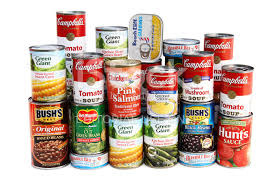
To survive well without getting malnourished, you’ll need protein, carbohydrates, vitamins, minerals, and a little fat – the basic food groups, though meat and dairy aren’t essential. Unless you have your own well-guarded farm or hunting preserve, you can’t count on being able to eat meat. And if you’re growing your own food, in most cases you’ll get much more protein per acre by growing beans instead of animals. But chickens and milk goats can be very useful and will take up less space than other critters. You’ll need to learn some animal husbandry between now and the end of the modern world.

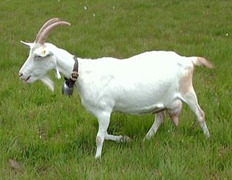
Whole proteins are made up of eight essential amino acids. Most beans and nuts have seven of those acids, while most grains have only one. To get whole protein from beans or nuts, you need a companion grain to eat with them, in order to make the protein complete. Think beans and rice, beans with tortillas, beans with cornbread, hummus and crackers, peanut butter sandwiches (made with pancakes or biscuits cooked over an open fire).
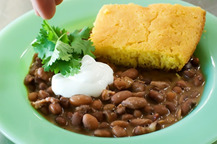
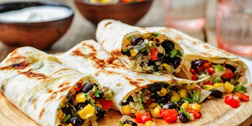


Soybeans have the full eight essential amino acids, but they take a ton of time and water to cook. My personal experience with them (which is extensive) is that they aren’t digestible unless they’ve been pressure-cooked for at least an hour, and pressure cookers can be dangerous and hard to come by. Soybean skins tend to plug up the vent holes. If the cooker isn’t removed from the fire immediately and the skin isn’t removed from the vent, the cooker could explode. People can get burned by the buildup of steam inside the cooker.
Soybeans are a pain in the ass (though probably less so than slaughtering meat). BUT, if you need whole protein, soybeans will provide it. The flavor’s not the best but it’s okay, the texture can be off-putting, but they’re not bad in tortillas with salsa and veggies. Once the beans are cooked, you can make decent patties out of them, if you have anything to flavor them with. Some women, like me for instance, can’t eat soybeans when they’re pregnant, and soy allergies are serious issues for many. If you have a lot of water, you can make soybeans into soy milk and tofu. There’s also tempeh, the making of which is an art-form.
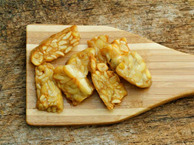


You can make milk out of lots of things these days: almonds, oats, rice, hemp (my fave). I don’t have a clue how to make these things, but I’m sure you can figure it out—if you get to googling while the internet still works.
In my novel, prepper Grandma Bea stocks barrels and bags of many kinds of beans, flours, oatmeal, rice, cooking oil, peanut butter, coffee, salt and pepper. She has cases of canned goods—mostly soup, chili, and stew, and cases of powdered milk and eggs.
6. GROWING FOOD
If you want to get serious about providing for long-term survival (or if you just want to live more sustainably), you will need to do more than stockpile food. You need to set yourself up with ways to grow it. Think garden beds full of rich soil, compost piles, bee hives for honey, fruit trees and vines, and ways to scare off the birds and critters. And you need to stockpile seeds that suit your soil, drainage, and growing season, along with plenty of organic fertilizer and the tools and equipment to help it all grow. You’ll need to get creative about where and how to grow this food: in your suburban yard, inside in front of your windows, in pots and buckets and barrels, on rooftops and ledges, along fences, etc., etc.
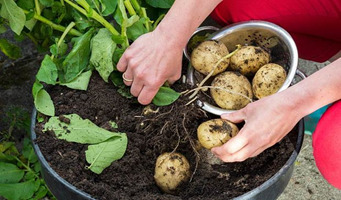




My main character, Bea, has fresh tomatoes, peppers, squash, greens, purple hull peas, and herbs growing in pots and in her garden. She has a second garden full of root veggies, and she has a bee hive installed in an exterior wall. A few neighbors have chickens. One family has some rabbits. When the neighbors finally get organized, Bea has plans for urban farming that involve building gardens and compost piles in yards and vacant lots, and later plowing up front yards for cornfields, plus the neighborhood park to try growing winter wheat and other grains in the scorching Texas heat.

7. STORING & PRESERVING FOOD
In my novel, Bea has a root cellar full of root veggies: russet and sweet potatoes, carrots, garlic, and onions. Beets don’t grow so well in Texas as far as I know (meaning, I don’t actually know). Turnips are, well, turnips, but they last a long time in cool, dry storage. Parsnips, rutabagas, and Jerusalem artichokes are other good root veggies to grow and store.
Root cellars are awesome if you can keep them from filling with ground water. Being under the earth tends to keep the temperatures nice for storage of food with a long shelf-life, like root veggies and—for a lesser length of time—compact cabbages, pumpkins, and winter squash (butternut, acorn, etc.)
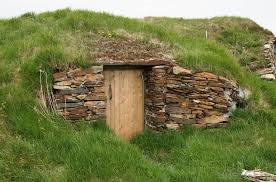

Though impractical when water is scarce, home canning is also a good way to store food. Many foods can be dried, which requires water only for cleaning before and after drying. Of course, you will need water to reconstitute most dried foods before you eat them, with dried fruit and jerky being the primary exception to this, and field corn, which can be ground into cornmeal.

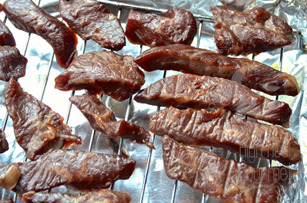
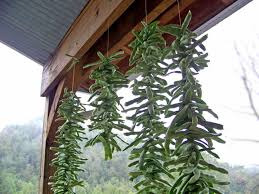
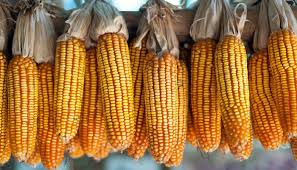

On top of growing and preserving food, you also need to know how to preserve seed, since there will be no new seed catalogs, no seed companies. The Seed Savers Exchange is one of many good resources for this: https://www.seedsavers.org/how-to-save-seeds.
Remember that you’ll also need biodiversity (more than one kind of seed for each veggie) to give you better odds that some types will survive a blight, fungus, or insect attack. You need ways to deal with such problems with the things you have on hand. And you need to protect your pollinators: bees, wasps, butterflies, etc. Know your bugs and learn to distinguish the helpful ones from the harmful ones. Crickets can be eaten (sorry, but you may need to know this someday).

I could go on about food forever (I already have, lol), but going further would be beyond the scope of this blog. My advice is to get busy studying up.
If all else fails, you can follow the example of Mad Max in ROAD WARRIOR and chow down on delicious cans of dog food.

We may find ourselves eating this poor guy out of our backyard someday:

STAY TUNED FOR FUTURE INSTALLMENTS OF “WHAT TO STOCK FOR AN APOCALYPSE.”
NEXT UP: SOLAR & WIND POWER
1 note
·
View note